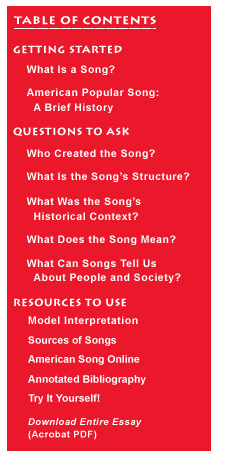talking history | syllabi | students | teachers | puzzle | about us

|
 |
|
“Dixie” (1859), a familiar song from the nineteenth century, was composed and performed by Dan Emmett (a white native of Ohio) in 1859 when he was a member of the Bryant’s Minstrels troupe in New York City. It was to be a new closing, or “walk-around,” number for the group’s show. The style in which Bryant’s Minstrels and similar minstrel troupes performed “Dixie” owed a great deal to African-American traditions of singing, dancing, and banjo playing. In its catchy polka rhythm it resembles earlier minstrel songs like “Turkey in the Straw” (1824) or “Oh Susanna” (1848). Its text, like the closing “walk arounds” from other minstrel shows, pictured the South as a happy land bathed in rural nostalgia, an appealing contrast, perhaps, to the urban squalor of New York, not to mention its cold winter weather. The chorus to “Dixie” (“I wish I was in Dixie, Hooray, Hooray!” etc.), tells us what we already know: that sectionalism and slavery were important issues in American politics in 1859, particularly in defining the distinctness of the South and the North. When the Civil War came in 1861, “Dixie” reinforced and strengthened southern white identity. Some lines of the chorus (“In Dixie land I’ll take my stand, live and die in Dixie”) hint at the belligerence of southern sentiment in the 1850s and helped symbolize white southern defiance ever after, eventually including defiance of the civil rights movement in the 1950s and 1960s. On the other hand, the jaunty rhythm seems to imply that sectionalism and factionalism are just a kind of sport. To the white audience at a minstrel show in New York, with white men using burnt-cork to portray “darkies” singing about the joys of the rural South, it may indeed have sounded this way and served to help deny the cruelty of slavery or the importance of sectional differences. Indeed, many of the lyrics to “Dixie” had nothing to do with slavery or other moral and political differences between the sections (“Old Missus marry Will de Weaber [weaver], Will-yum was a gay deceaber [deceiver]” or “Dars buckwheat cakes an’ ingen [Indian] batter, makes you fat or a little fatter”). But by 1861 the Confederacy had taken up the song as its anthem and marching song, beginning when it was played at Jefferson Davis’s inauguration as President of the Confederacy. Its meanings in the South became very different from its meanings in the North, where it usually signified rebellion, support for slavery, and sedition. Northern publishers issued versions of the song with titles like “Dixie Unionized,” with the words rewritten to support the northern cause, but these never really caught on. Even so, “Dixie” remained one of Abraham Lincoln’s favorite songs and he requested it be played for him a few days before his assassination, saying “I have always thought ‘Dixie’ one of the best tunes I have ever heard. Our adversaries over the way attempted to appropriate it, but I insisted yesterday that we fairly captured it. . . .” For large numbers of Americans in both North and South, however, the song retained its wartime and racial connotations well into the twentieth century. In the North, “Dixie” returned gradually to the repertory, but mainly in private rather than public contexts (although it appeared as a “Patriotic Song” in a collection published in Boston in 1888). In the theater it was typically heard in parody versions or as a quotation within another song, as when used ironically by African-American performers like Noble Sissle and Eubie Blake in “Bandana Days” from their 1921 musical Shuffle Along. Other than online sheet music, what sources might exist for helping us understand the song, its influence, and its meaning to different people? Sources for “Dixie” include Dan Emmett’s autographed copy of the song, which has been preserved at the Ohio Historical Society and the publication of the words without the music in a little songster called Bryant’s Power of Music in 1859. Recorded performances of “Dixie”—by choral groups, by marching bands, by “Dixieland” bands, etc. —also count as sources. So do parody versions and snatches of the words or tune. Dan Emmett’s letters and notebooks illuminate some of the early contexts of “Dixie”; so do newspaper and magazine accounts of performances by Bryant’s Minstrels in New York. “Dixie” also had many later contexts, documented by accounts of minstrel shows, photographs, arguments in the press, legal proceedings, and movies. The latter include a highly fictional 1943 film biography of Dan Emmett, starring Bing Crosby. Perhaps there is some significance to the fact that such a movie appeared during World War II, a time when Hollywood was trying to promote national unity. During the civil rights movement and afterward, “Dixie” often served as an anthem for white southerners and a reminder of slavery and racism for African Americans. That sometimes produced ironic results. In the 1960s an exiled black power advocate, Robert Williams, called his radio broadcast from Havana “Radio Free Dixie.” In 2002 the same phrase appeared on a Web site advising white southerners on how to proclaim their confederate heritage. The historical sources for “Dixie” clearly encompass a tremendous diversity of materials, dating from 1859 up to the present and much of its curious history remains untold. It is often offensive to African Americans. For example, a recent book by Howard and Judith Sacks, Way up North in Dixie: A Black Family’s Claim to the Confederate Anthem (Washington: Smithsonian Institutions Press, 1993), argues that “Dixie” was not composed by Dan Emmett, but came from the repertory of the Snowden family, black musicians who were neighbors of Emmett’s in Mt. Vernon, Ohio. The Sacks’s book is a reminder that “Dixie” is a part of our national cultural heritage and continues to have multiple meanings nearly a century and a half after it was first sung. |
|

|
|
